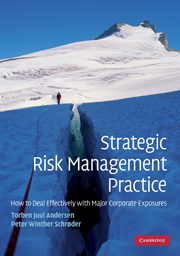Book contents
- Frontmatter
- Contents
- List of abbreviations
- List of figures
- List of tables
- List of boxes
- Preface
- 1 The strategic nature of corporate risk management
- 2 Economic exposures in corporate risk management
- 3 Managing market-related business exposures
- 4 Extending the risk management perspective
- 5 Integrative risk management perspectives
- 6 Current risk management practice and the rise of ERM
- 7 Strategic risk analyses
- 8 Strategic risk management – amendments to the ERM framework
- 9 Strategic risk management
- 10 Postscriptum
- Appendices
- Appendix 1 A strategic responsiveness model
- Appendix 2 Determining the premium on a call option
- Appendix 3 Determining the value of a real option
- Index
- References
5 - Integrative risk management perspectives
Published online by Cambridge University Press: 05 June 2012
- Frontmatter
- Contents
- List of abbreviations
- List of figures
- List of tables
- List of boxes
- Preface
- 1 The strategic nature of corporate risk management
- 2 Economic exposures in corporate risk management
- 3 Managing market-related business exposures
- 4 Extending the risk management perspective
- 5 Integrative risk management perspectives
- 6 Current risk management practice and the rise of ERM
- 7 Strategic risk analyses
- 8 Strategic risk management – amendments to the ERM framework
- 9 Strategic risk management
- 10 Postscriptum
- Appendices
- Appendix 1 A strategic responsiveness model
- Appendix 2 Determining the premium on a call option
- Appendix 3 Determining the value of a real option
- Index
- References
Summary
In this chapter we look at some of the traditional risk management practices adopted by many companies to deal with their most essential exposures. The applicability of financial hedging is discussed and the limitations of this approach are pointed out while arguing that organizations should take a more integrative look across different types of risk effects and consider exposures over different time spans. As a natural outgrowth of this discussion it appears that companies should complement their risk management activities with a more strategy-oriented perspective in their hedging considerations. Finally, the practical challenges associated with managing the myriad of risks faced by modern corporations are addressed.
The need to look across risks
It is common practice in many, if not most, companies to hedge their anticipated future foreign-currency-denominated cash flows over a certain period of time, cf. the example from the Danish pharmaceutical company Lundbeck (see Box 5.1 Lundbeck – foreign exchange exposure).
The main reason for engaging in these hedging exercises is to limit negative short- to medium-term impacts from foreign-currency-denominated cash flows when they are converted to the home currency of accounting and thereby reduce adverse earnings effects from exchange rate fluctuations in the major invoicing currencies. These exposures typically relate to transactions recorded in the books as corporate receivables or payables, the local value of which will vary with changes in the foreign exchange conversion. The bulk of booked international commercial transactions do not extend beyond the current and next accounting year and can be hedged, for example, by engaging in forward foreign exchange or financial futures contracts that, for the same reason, only rarely exceed a maturity of twelve to eighteen months.
- Type
- Chapter
- Information
- Strategic Risk Management PracticeHow to Deal Effectively with Major Corporate Exposures, pp. 99 - 119Publisher: Cambridge University PressPrint publication year: 2010



